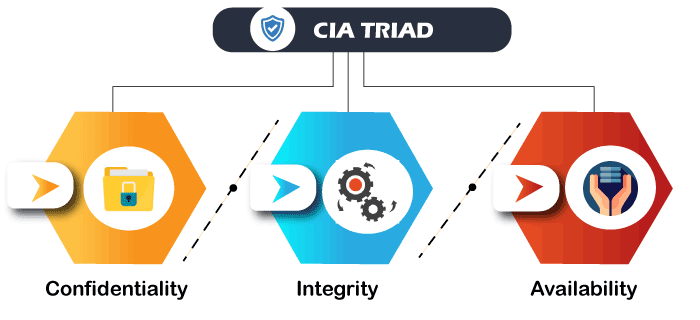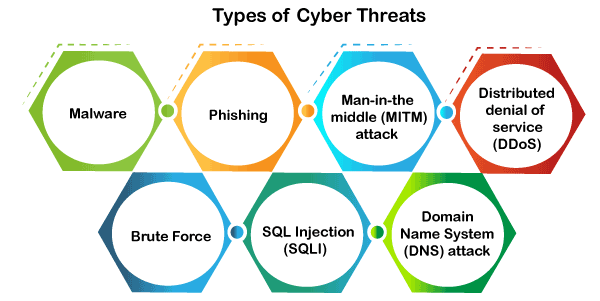What is Cyber Security?The technique of protecting internet-connected systems such as computers, servers, mobile devices, electronic systems, networks, and data from malicious attacks is known as cybersecurity. We can divide cybersecurity into two parts one is cyber, and the other is security. Cyber refers to the technology that includes systems, networks, programs, and data. And security is concerned with the protection of systems, networks, applications, and information. In some cases, it is also called electronic information security or information technology security. 
Some other definitions of cybersecurity are: "Cyber Security is the body of technologies, processes, and practices designed to protect networks, devices, programs, and data from attack, theft, damage, modification or unauthorized access." "Cyber Security is the set of principles and practices designed to protect our computing resources and online information against threats." Types of Cyber SecurityEvery organization's assets are the combinations of a variety of different systems. These systems have a strong cybersecurity posture that requires coordinated efforts across all of its systems. Therefore, we can categorize cybersecurity in the following sub-domains:
Importance of Cyber SecurityToday we live in a digital era where all aspects of our lives depend on the network, computer and other electronic devices, and software applications. All critical infrastructure such as the banking system, healthcare, financial institutions, governments, and manufacturing industries use devices connected to the Internet as a core part of their operations. Some of their information, such as intellectual property, financial data, and personal data, can be sensitive for unauthorized access or exposure that could have negative consequences. This information gives intruders and threat actors to infiltrate them for financial gain, extortion, political or social motives, or just vandalism. Cyber-attack is now an international concern that hacks the system, and other security attacks could endanger the global economy. Therefore, it is essential to have an excellent cybersecurity strategy to protect sensitive information from high-profile security breaches. Furthermore, as the volume of cyber-attacks grows, companies and organizations, especially those that deal with information related to national security, health, or financial records, need to use strong cybersecurity measures and processes to protect their sensitive business and personal information. Cyber Security GoalsCyber Security's main objective is to ensure data protection. The security community provides a triangle of three related principles to protect the data from cyber-attacks. This principle is called the CIA triad. The CIA model is designed to guide policies for an organization's information security infrastructure. When any security breaches are found, one or more of these principles has been violated. We can break the CIA model into three parts: Confidentiality, Integrity, and Availability. It is actually a security model that helps people to think about various parts of IT security. Let us discuss each part in detail. 
Confidentiality Confidentiality is equivalent to privacy that avoids unauthorized access of information. It involves ensuring the data is accessible by those who are allowed to use it and blocking access to others. It prevents essential information from reaching the wrong people. Data encryption is an excellent example of ensuring confidentiality. Integrity This principle ensures that the data is authentic, accurate, and safeguarded from unauthorized modification by threat actors or accidental user modification. If any modifications occur, certain measures should be taken to protect the sensitive data from corruption or loss and speedily recover from such an event. In addition, it indicates to make the source of information genuine. Availability This principle makes the information to be available and useful for its authorized people always. It ensures that these accesses are not hindered by system malfunction or cyber-attacks. Types of Cyber Security ThreatsA threat in cybersecurity is a malicious activity by an individual or organization to corrupt or steal data, gain access to a network, or disrupts digital life in general. The cyber community defines the following threats available today: 
MalwareMalware means malicious software, which is the most common cyber attacking tool. It is used by the cybercriminal or hacker to disrupt or damage a legitimate user's system. The following are the important types of malware created by the hacker:
PhishingPhishing is a type of cybercrime in which a sender seems to come from a genuine organization like PayPal, eBay, financial institutions, or friends and co-workers. They contact a target or targets via email, phone, or text message with a link to persuade them to click on that links. This link will redirect them to fraudulent websites to provide sensitive data such as personal information, banking and credit card information, social security numbers, usernames, and passwords. Clicking on the link will also install malware on the target devices that allow hackers to control devices remotely. Man-in-the-middle (MITM) attackA man-in-the-middle attack is a type of cyber threat (a form of eavesdropping attack) in which a cybercriminal intercepts a conversation or data transfer between two individuals. Once the cybercriminal places themselves in the middle of a two-party communication, they seem like genuine participants and can get sensitive information and return different responses. The main objective of this type of attack is to gain access to our business or customer data. For example, a cybercriminal could intercept data passing between the target device and the network on an unprotected Wi-Fi network. Distributed denial of service (DDoS)It is a type of cyber threat or malicious attempt where cybercriminals disrupt targeted servers, services, or network's regular traffic by fulfilling legitimate requests to the target or its surrounding infrastructure with Internet traffic. Here the requests come from several IP addresses that can make the system unusable, overload their servers, slowing down significantly or temporarily taking them offline, or preventing an organization from carrying out its vital functions. Brute ForceA brute force attack is a cryptographic hack that uses a trial-and-error method to guess all possible combinations until the correct information is discovered. Cybercriminals usually use this attack to obtain personal information about targeted passwords, login info, encryption keys, and Personal Identification Numbers (PINS). SQL Injection (SQLI)SQL injection is a common attack that occurs when cybercriminals use malicious SQL scripts for backend database manipulation to access sensitive information. Once the attack is successful, the malicious actor can view, change, or delete sensitive company data, user lists, or private customer details stored in the SQL database. Domain Name System (DNS) attackA DNS attack is a type of cyberattack in which cyber criminals take advantage of flaws in the Domain Name System to redirect site users to malicious websites (DNS hijacking) and steal data from affected computers. It is a severe cybersecurity risk because the DNS system is an essential element of the internet infrastructure. Latest Cyber ThreatsThe following are the latest cyber threats reported by the U.K., U.S., and Australian governments: Romance ScamsThe U.S. government found this cyber threat in February 2020. Cybercriminals used this threat through dating sites, chat rooms, and apps. They attack people who are seeking a new partner and duping them into giving away personal data. Dridex MalwareIt is a type of financial Trojan malware identifies by the U.S. in December 2019 that affects the public, government, infrastructure, and business worldwide. It infects computers through phishing emails or existing malware to steal sensitive information such as passwords, banking details, and personal data for fraudulent transactions. The National Cyber Security Centre of the United Kingdom encourages people to make sure their devices are patched, anti-virus is turned on and up to date, and files are backed up to protect sensitive data against this attack. Emotet MalwareEmotet is a type of cyber-attack that steals sensitive data and also installs other malware on our device. The Australian Cyber Security Centre warned national organizations about this global cyber threat in 2019. The following are the system that can be affected by security breaches and attacks:
Benefits of Cyber SecurityThe following are the benefits of implementing and maintaining cybersecurity:
Cyber Safety TipsLet us see how to protect ourselves when any cyberattacks happen. The following are the popular cyber safety tips: Conduct cybersecurity training and awareness: Every organization must train their staffs on cybersecurity, company policies, and incident reporting for a strong cybersecurity policy to be successful. If the staff does unintentional or intentional malicious activities, it may fail the best technical safeguards that result in an expensive security breach. Therefore, it is useful to conduct security training and awareness for staff through seminars, classes, and online courses that reduce security violations. Update software and operating system: The most popular safety measure is to update the software and O.S. to get the benefit of the latest security patches. Use anti-virus software: It is also useful to use the anti-virus software that will detect and removes unwanted threats from your device. This software is always updated to get the best level of protection. Perform periodic security reviews: Every organization ensures periodic security inspections of all software and networks to identify security risks early in a secure environment. Some popular examples of security reviews are application and network penetration testing, source code reviews, architecture design reviews, and red team assessments. In addition, organizations should prioritize and mitigate security vulnerabilities as quickly as possible after they are discovered. Use strong passwords: It is recommended to always use long and various combinations of characters and symbols in the password. It makes the passwords are not easily guessable. Do not open email attachments from unknown senders: The cyber expert always advises not to open or click the email attachment getting from unverified senders or unfamiliar websites because it could be infected with malware. Avoid using unsecured Wi-Fi networks in public places: It should also be advised not to use insecure networks because they can leave you vulnerable to man-in-the-middle attacks. Backup data: Every organization must periodically take backup of their data to ensure all sensitive data is not lost or recovered after a security breach. In addition, backups can help maintain data integrity in cyber-attack such as SQL injections, phishing, and ransomware.
Next TopicHistory of Cyber Security
|
 For Videos Join Our Youtube Channel: Join Now
For Videos Join Our Youtube Channel: Join Now
Feedback
- Send your Feedback to [email protected]
Help Others, Please Share










